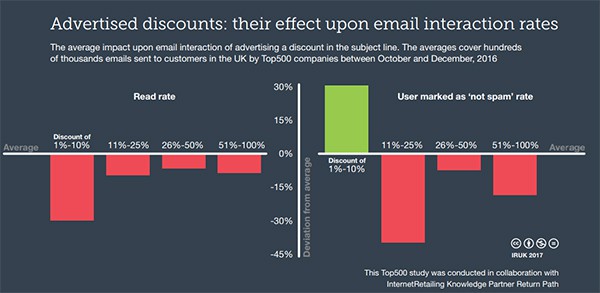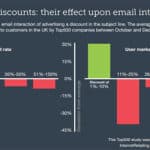Black Friday, Cyber Monday, Christmas… the key retail dates come thick and fast at the end of the year. Fernando Santos looks at how retailers use email to try to maximise sales over this crucial period
As InternetRetailing’s research has built up over the years, one of the areas where we’ve gained the keenest insights is in the use of email. This may sound old school but as we noted in our analysing the numbers feature, email remains many customers’ preferred means of contact when dealing with brands.
It follows that when retailers don’t manage to communicate well via email – by which we mean efficiently and with personalised emails carefully tailored to what customers may be interested in – this will be reflected in overall performance.
It’s, therefore, heartening to report that over the past three months, UK retailers have performed strongly, according to our latest research conducted in conjunction with Knowledge Partner Return Path. Compared to an average read rate of 14% across all senders, the figure for UK retailers is 19%.
That’s not to say there aren’t areas where retailers could do better. In the run-up to Black Friday and Christmas, the number of emails being sent increases, for obvious reasons. Yet as this happens, there’s also an increase in the number of emails that get snarled up in spam filters. Turning to user-marked spam rates, these are relatively low, although this may have something to do with customers increasingly accessing emails via mobile, where it’s not always easy to mark emails as spam.
Read rates
Drilling down into the figures, there’s clearly a competitive edge to be gained by being a retailer whose emails are actually read by customers. Read rate is a more accurate description than open rate in that it accounts for all emails viewed, regardless of image rendering. Here, high achievers include Top500 retailers such as Amazon, Very.co.uk and Apple.
“Amazon is consistently held up as the benchmark for targeted/relevant email based on demonstrated needs and interests, and this is demonstrated in the data we have analysed,” says Guy Hanson, senior director, professional services, at Return Path.
Amazon’s strong performance continues in mailbox provider (MBP) marked spam rates, where M&S and John Lewis also excel. In contrast, says Hanson, “Three of the senders with the lowest read rates are also the senders with the highest filtering rates.” This points to a fundamental truth – that emails will not get read if they aren’t being consistently delivered to subscribers’ inboxes.
What about users marking emails as either ‘spam’ or ‘not spam’? While emails from eBay and John Lewis are rarely marked as spam, the same can’t be said of other retailers in the Top500. As for those emails that users mark as ‘not spam’ or ‘not junk’, Superdrug, among others, performs strongly here. However, we would add a caveat.
A low ‘this is not spam’ rate will not be a problem if a company’s emails aren’t being marked as spam in the first place.
Turning to forwarding rates, emails from Amazon, Apple and M&S are most regularly shared. Conversely, our research revealed there are still companies that underperform when compared to the rest of the industry in terms of their emails being deleted without being looked at. Subject line testing may help here.
When to send
The research was particularly revealing because it covered Christmas as well as Black Friday and Cyber Monday – two dates that are emerging as increasingly important within retail. As you might expect, email volumes doubled in November when compared to October as retailers prepared for all three of these dates. In December during the run-up to Christmas, email volumes remained roughly at the same rate as in November.
Overall, British consumers didn’t seem to mind this too much, as indicated by the read rate for emails increasing over the three months, perhaps reflecting worries over getting Christmas gifts purchased in time. However, there was also an increase in the number of complaints.
Turning to pricing strategies, just 4% of the campaigns we reviewed used a pricing reference, for example, £9.99, in the subject line. This may be because such emails are more likely to get caught in spam filters (29.4% vs 14.2%) and also because the reading rate for such emails was lower (14.3% vs 19.2%).
Discounting strategies have similar trends to their pricing counterparts, although not as pronounced. The effect on read rate is less pronounced in the 26% to 50% discount range, with a drop of only 6% in comparison to the average. However, users are 30% more likely to manually retrieve emails from their spam filters if these messages contain an offer with a lower discount range (0% to 10%).
For those thinking ahead, advent calendars were a hit with consumers in 2016, one manifestation of a significant increase in the use of interactive content. Asda, for instance, used ‘reveal’ technology so that subscribers could see offers by scraping off the ‘covering’ like a digital take on a scratch card.
Guy Hanson notes, “Compared with Asda’s benchmark, read rates for the advent calendar emails were higher, filtering rates were lower and the likelihood of recovery from spam was significantly higher.”
For more email analysis, including a look at the festive season behaviour of Amazon’s UK customers, see our research blog posts at internetretailing.net







